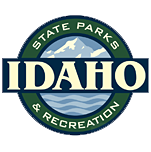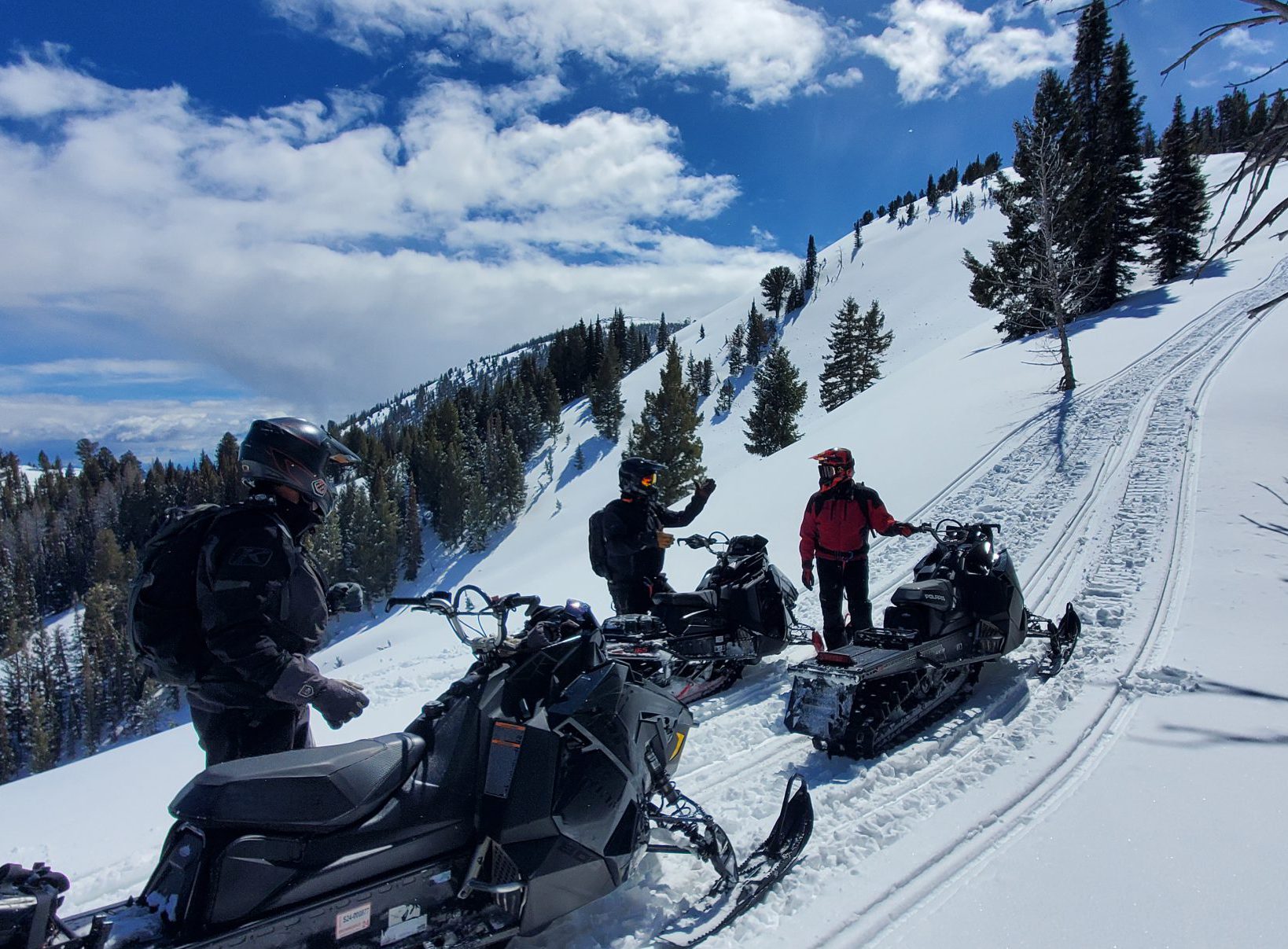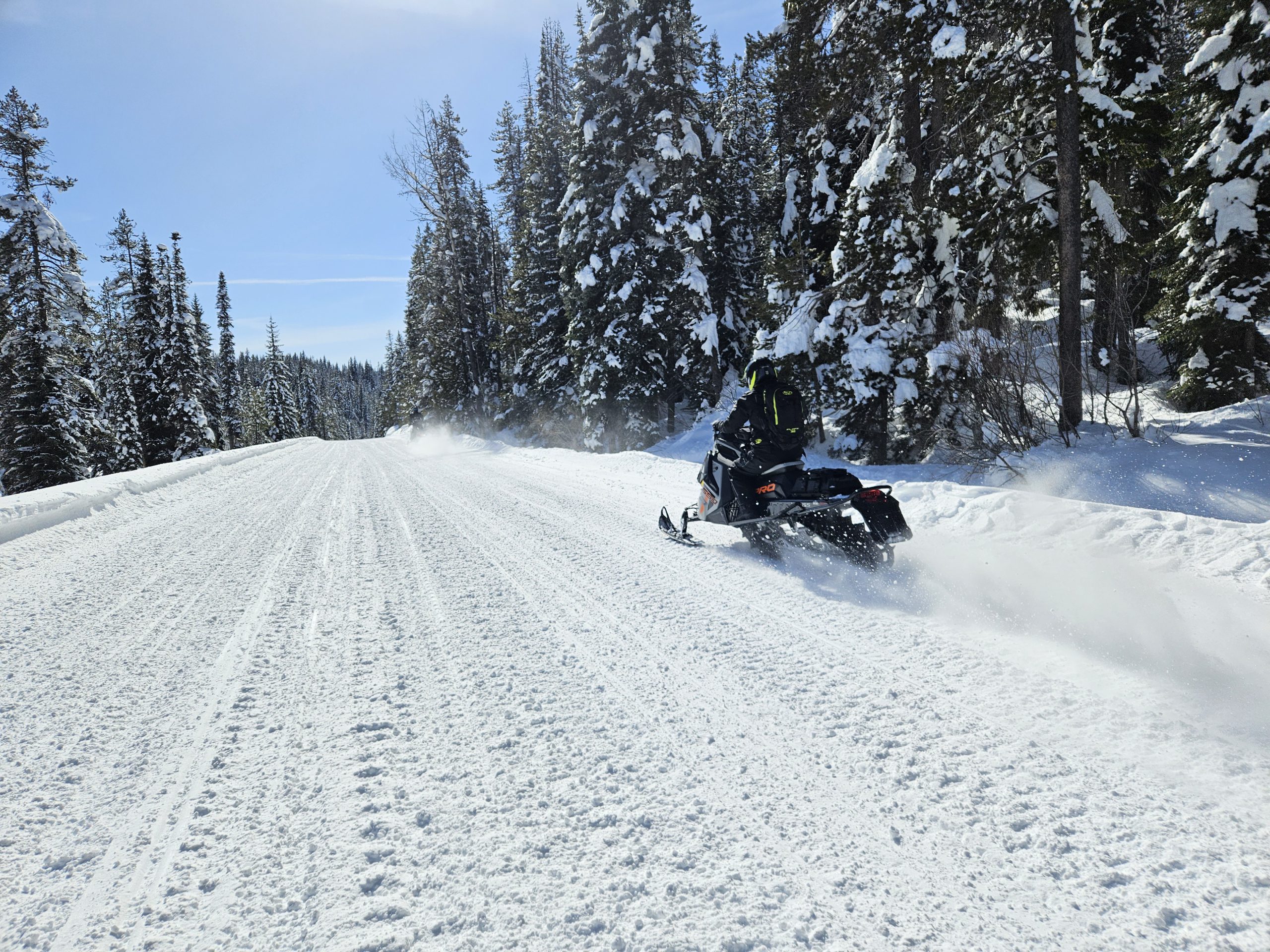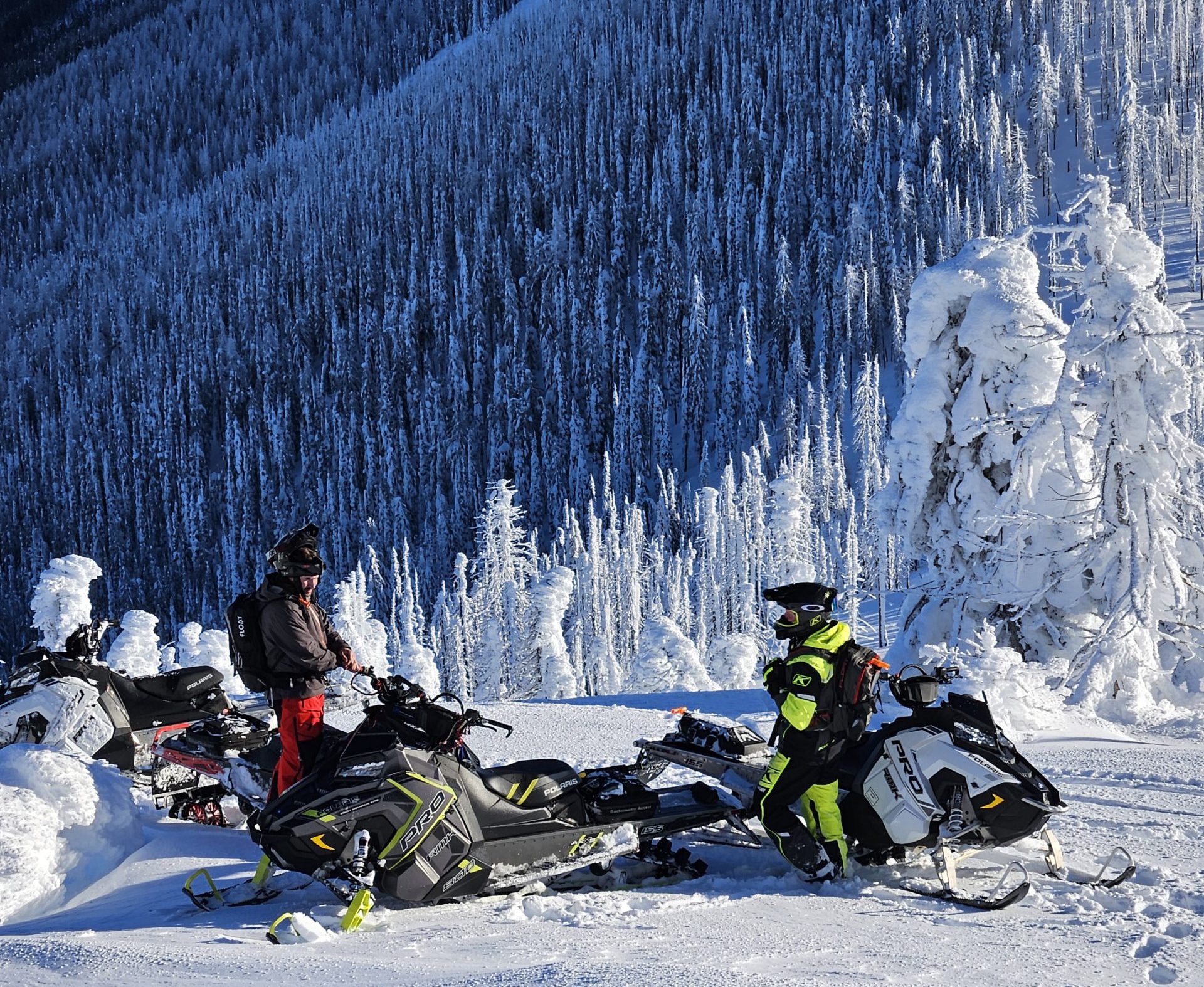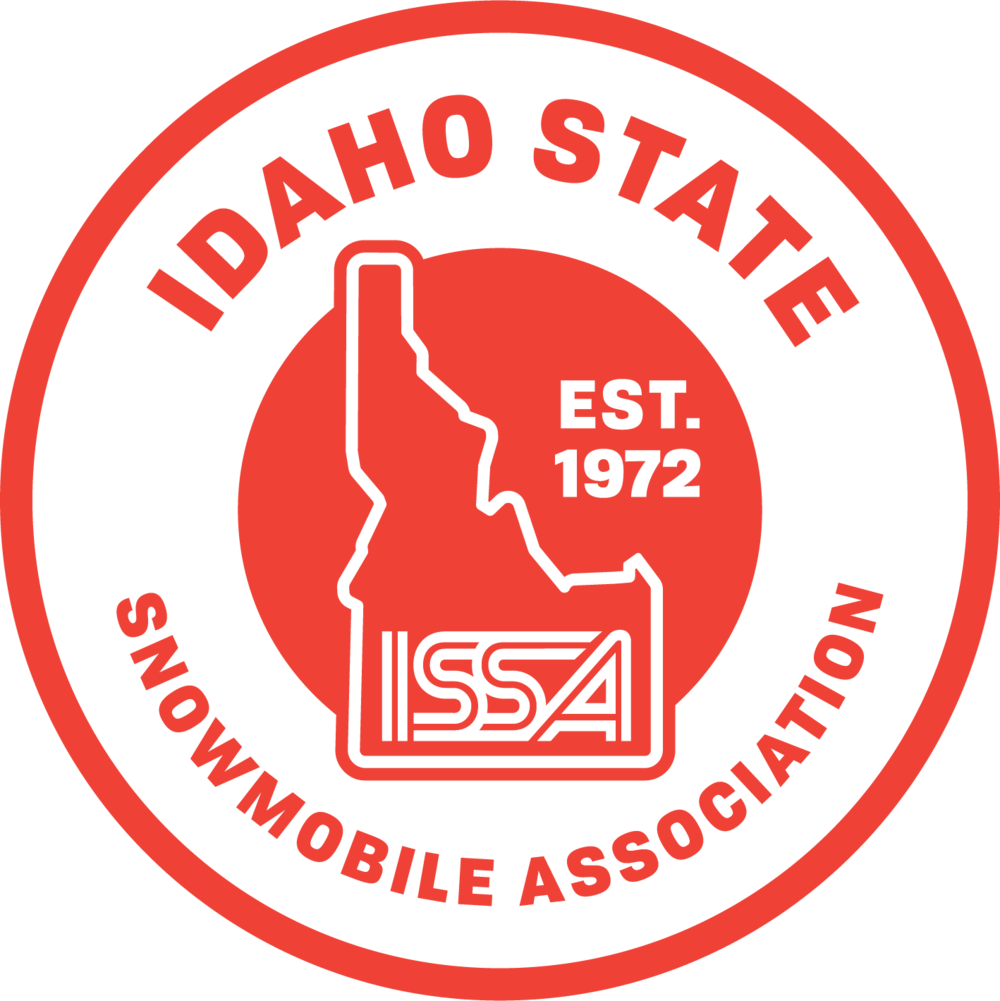 Official Government Website
Official Government WebsiteSnowmobiling
The Motorized Trails Program’s winter activities consist of the following:
- Working with counties and land managers to provide maintenance on groomed snowmobile trails
- Providing snowmobile education opportunities
- Partnering with snowmobile law enforcement programs
- Participating in statewide travel planning
- Working with snowmobile clubs and organizations
Economic Impact
Download the Economic Impact and Importance of Snowmobiling in Idaho.
Designations
To ensure the area you ride has enough funding to operate throughout the season, please designate your certificate of number fees to the county you ride.
The Idaho snowmobile program is funded through certificate-of-number fees purchased by snowmobilers. On November 1 of each year every snowmobile operated on private or public land must be numbered.
Fees
Resident: $45.50
Non-Resident: $59.50
Rentals: $75.50
You may also purchase a resident 2-year for $89.50 and non-resident 2-year for $117.50.
Note: non-residents are not exempt from purchasing an Idaho snowmobile certificate of number.
How is your certificate of number fee broken down?
- $1.50 vendor fee
- $1.00 to snowmobile related search and rescue efforts
- 85% goes to the county-operated snowmobile grooming programs
- Up to 15% goes to administration fees and the printing costs of registration stickers
What are the certificate of number fees used for?
- Grooming
- Parking lot plowing
- Signing
- Clearing groomed trails
- Avalanche classes
- New rider classes
Snowmobile Stickers
Purchase one or two-year resident and non-resident snowmobile/snowbike/tracked-OHV stickers at vendors or online. Stickers will be mailed to you, and your email receipt is your temporary permit.
Local Sticker Vendors
If you need to review your current, unexpired recreation permits and they do not appear when you access the online system, please call 1-888-922-6743 for assistance.
When does grooming occur?
Grooming happens as weather, snow, and safety permit. The bullets below briefly identify when programs groom trails.
- When the safety of the equipment and operators is not a concern.
- When there is a minimum of 18” of snow in the parking lot.
- When avalanche conditions do not pose a safety concern for grooming operations.
- When the grooming temperatures are between -20⁰F and 40⁰F.
Rider Community
Check out the Idaho State Snowmobile Association for additional information, regional club lists, and more! Click here or the logo below to be re-directed to their site.
Priest Lake
State Designated Area: #9A
Elevation: 2,500–6,500
Prime Season: Dec–March
Route: Idaho Highway 57
Lodging/Services Info: (888) 774-3785
priestlake.org
Map Info: (208) 443-2512
Priest Lake boasts more than 400 miles of groomed trails that wind through heavy timber, endless windswept ridges and snow-filled bowls. North of Nordman, the Granite Pass trail system consists of four groomed trails stretching nearly 100 miles. The highest peaks range from 6,000 to 7,000 feet. Priest Lake accommodations range from luxury resorts, condominiums, rustic cabins, roadside motor inns, and charming bed and breakfasts.
Sandpoint and Bonners Ferry
State Designated Area: #9B
Elevation: 2,500–7,200
Prime Season: Dec–March
Route: U.S. 95 and U.S. 2
Lodging/Services Info: (208) 267-5922 (Bonners Ferry) or (800) 800-2106 (Sandpoint)
sandpointchamber.org
Map Info: (208) 263-5111
Located 40 miles north of Coeur d’Alene and 25 miles south of the Canadian border, the Sandpoint/ Bonners Ferry area offers more than 100 miles of marked and groomed trails. This area of breathtaking mountain peaks is Canada’s gateway to Silver Country. Favorite riding areas include: Spruce Lake, Copper Ridge, Deer Creek, Canuck, Roman Nose Lakes, Apache Ridge and Dodge Peak to the southwest, and Cooks Pass to the west.
Coeur d'Alene
State Designated Area: #28
Elevation: 3,000–5,000
Prime Season: Jan–March
Miles From Town: 12
Route: U.S. 95
Lodging/Services/Map Info: (208) 664-3194
fyinorthidaho.com
A tradition of timber and mining has created an extensive network of trails in the Coeur d’Alene/ Kootenai County area. These trails provide snowmobilers with 350 miles of diverse riding conditions within easy access off Interstate 90. From straight high-speed “highways” to high-mountain switchbacks, there’s a trail for any rider. The Coeur d’Alene system connects with the Wallace trail system and on to Haugan and St. Regis, MT, a 1,000-mile trek of unparalleled scenery, accommodations and accessibility. Closer to Coeur d’Alene at the Fernan Saddle, elevations range from 2,500 feet to more than 6,000 feet. 12 miles east of Coeur d’Alene, the Fourth-of-July system offers 54 miles of trails for the snowmobile enthusiast. Numerous trail systems can also be found near the towns of Hayden and Hayden Lake, including the 43-mile Hayden Creek-Horse Heaven Loop. Ten miles southeast of Athol is the Bunco Trail System which takes in four groomed trails totaling 60 miles.
Wallace
State Designated Area: #40
Elevation: 2,700–5,000
Prime Season: Dec–March
Full Service Towns: Wallace, Kellogg, Avery
Route: Interstate 90
Lodging/Services/Map Info: (208) 753-7151
wallaceidaho chamber.com
Experienced snowmobilers and families love the challenge of this rustic area. Historic Wallace is Idaho’s Snowmobile City, USA, and features some of the finest high-mountain snowmobiling in the world. Historic Wallace is snowmobile-friendly and features an ‘open streets’ ordinance welcoming riders to access area trails from anywhere in town. Located high in the Bitterroot Mountains near the Idaho/ Montana border, this beautiful 1880’s Old West mining town is listed on the National Historic Register and is easily accessible via Interstate 90 from Seattle, Spokane and Missoula.
Avery
State Designated Area: #40B
Elevation: 2,700–5,000
Prime Season: Dec–March
Full Service Towns: Avery, Wallace
Lodging/Services Info: (208) 245-4410.
Map Info: (208) 245-4410.
scheffys.com
This once-thriving railroad town is now a great place to stage your snowmobile ride. With connection to the Wallace (area 40) program to the north and the beautiful St. Joe River County to the south. 4 trailheads leave from the town of Avery for easy access to approximately 180 miles of groomed trails, as well as large play areas and hill climbs for all skills of riders to enjoy. 2 warming huts are located on the hill for your comfort and safety. Gas, food and lodging are available in Avery. In the winter, Avery can be accessed by driving 47 miles up NFD Road #50 from St. Maries.
St. Maries
State Designated Area: #5
Elevation: 6,300–10,157
Prime Season: Dec–March
Full Service Towns: St. Maries
Miles From Town: 30 miles from St. Maries
Route: From St. Maries travel South on Hwy 5 to Santa, then South on Hwy 3 to Fernwood/Clarkia.
Lodging/Services Info: St. Maries Chamber of Commerce (208) 245-3563
U.S. Forest Service (800) 245-2531
stmaries chamber.org
North Idaho has the snow and terrain to create a snowmobiler’s paradise. Snowmobiling is one of the area’s fastest-growing sports. Because St. Maries is located in the Bitterroot Mountains, ski areas and snowmobiling opportunities are plentiful. In winter months, snowmobiling enthusiasts delight in miles of groomed trails and good snow. There are over 600 acres available just outside St. Maries for snowmobiling. In surrounding Benewah and Shoshone counties, the miles and miles of trails are endless for snowmobiling. A history of timber and mining has left an extensive network of trails through the Idaho Panhandle National Forest.
idahowinter.org.
Snowmobiling regulations and trail maps are available from U.S. Forest Service offices throughout the region. With the eminent success of snowmobiling projects throughout North Idaho, here’s a recommendation: Make plans for your visit before the rest of the world gets here!
Moscow
State Designated Area: #29
Elevation: 2,300–6,000
Prime Season: Dec–March
Route: U.S. 95
Lodging/Services Info: Elk River City Call (208) 826-3209
moscowchamber.com
Map Info: (208) 875-1131
Latah County offers 300 miles of groomed snowmobile trails spread over three areas. The largest is a 250-mile network of trails between the small towns of Bovill and Elk River. Northeast of Moscow on Moscow Mountain, a smaller system of trails extends along the ridge, down into a loop trail and back up to a spectacular view at the mountain’s summit (4,721 feet). East of the town of Harvard is a network of groomed trails with trailheads near Laird Park on Strychnine Creek and a few miles beyond at North Fork Creek.
Orofino
State Designated Area: #18
Elevation: 3,000–6,000
Prime Season: Dec–Apr
Full Service Towns: Orofino, Pierce, Weippe
Miles from Town: 20
Route: U.S. 12, Idaho Highway 11
Lodging/Services Info: (208) 476-4335
orofino.com
Map Info: (208) 476-4541
In Clearwater County, a panoramic view of the region is found at Bald Mountain Lookout, the site of a winter survival cabin for snowmobilers. This area features more than 200 miles of groomed and several miles of ungroomed trails. Trail rides and hill climbs can be enjoyed at elevations ranging from 3,000 to 6,000 feet.
Lewiston
State Designated Area: #35
Elevation: 3,000–5,000
Prime Season: Jan–March
Full Service Towns: Lewiston, Winchester
Miles from Town: 20
Route: U.S. 95
Lodging/Services Info: (800) 473-3543
ohwy.com/id/l/lewistcc.htm
Map Info: (208) 743-3531
Nez Perce County grooms 250 miles in the Waha Area in Nez Perce and Lewis counties. The trail system winds around Craig Mountain near Winchester and offers open and forested areas. Parking is available near Waha and Winchester.
Grangeville
State Designated Area: #25A
Elevation: 5,000–8,000
Prime Season: Nov–April
Miles From Town: 7
Route: U.S. 95, south on U.S. Forest Road 221
Lodging/Services Info:(208) 983-0460
Map Info: (208) 983-1950
The Grangeville area has a 150-mile groomed snowmobile trail system that begins seven miles south of Grangeville at Fish Creek Recreation Area. From there, groomed trails run south along the Old Milner Trail to the old town site of Florence and the breaks of the Salmon River. Side trips can be taken to the edge of the Gospel Hump Wilderness. The trail system to the west of Fish Creek has two groomed loops. The Goose Creek Loop provides access to High Camp, overlooking Grangeville and the Camas Prairie. The longer Service Flats Loop offers open ridges and views of the Seven Devils Mountains and the Salmon River Canyon.
Elk City/Dixie
State Designated Area: #25B
Elevation: 4,000–7,000
Prime Season: Dec–March
Route: U.S. 95,
Idaho Highways 13 and 14
Lodging/Services Info: (208) 842-2383
Map Info: (208) 842-2245
Central Idaho County (Elk City, Red River, and Dixie) offers approximately 200 miles of groomed trails. A wide variety of snowmobiling is available ranging from trails in heavy timber to open snowfields. Major trailheads are available at Elk City, Newsome Creek, Trapper Creek and Dixie.
McCall
State Designated Area: #43A
Elevation: 5,000–8,000
Prime Season: Dec–April
Route: Idaho Highway 55
Lodging/Services Info: (208) 634-7631
mccallchamber.org
Map Info: (208) 634-0427
This popular recreation area features some of the best snowmobiling in the state with well-groomed trails and backcountry play areas. Snowmobile trails take off from Cascade, Donnelly, and McCall. The trail accesses the Lady Bug Play Area, where acres of powder await. The Railroad Pass Trail takes you into Warm Lake, Deadwood, and Yellow Pine where fuel, food, and lodging are available. Area byways offer access to backcountry areas such as Goose Lake, Brundage Reservoir, Granite Lake, Little Payette Lake, Warren, Secesh, Red Ridge, and Blue Bunch. Warren and Secesh have food and lodging available. Parking areas west and north of McCall provide off-highway parking and easy access to trails.
Smiths Ferry/Cascade/Warm Lake
State Designated Areas:
#43B, #43C, #43D
Elevation: 5,000–8,000
Prime Season: Dec–April
Route: Idaho Highway 55
Lodging/Services Info: (208) 382-3833
Map Info: (208) 634-0427
Sixty miles north of Boise on Highway 55, snowmobile trails take off from Smith’s Ferry and 18 miles further north in Cascade. The Wellington Snow Park (near Smith’s Ferry) offers 400 miles of trails, 250 of which are groomed, with access to McCall, Cascade, Ola, Stanley, Warm Lake and Garden Valley. The Winter Wonderland Trail leaves the mountain meadows of Smith’s Ferry, weaves past the towns of Cascade and Donnelly and crosses the mountains, offering spectacular scenic vistas at over 7,900 feet-before reaching McCall.
Garden Valley
State Designated Area: #8B
Elevation: 3,000–8,000
Prime Season: Dec–March
Miles from Town: 5
Route: Idaho Highway 55, turn east at Banks
Lodging/Services Info:(208) 462-5003
Fax: (208) 462-3703
gvchamber.org
Map Info: (208) 634-0427
The Garden Valley snowmobile trail system begins at the Terrace Lake Resort. A total of 137 miles are groomed, leading to Packer John and connecting with the trail system maintained by the Smith’s Ferry grooming program. Garden Mountain can also be reached from the trail system, though the route is ungroomed.
Idaho City
State Designated Area: #8A
Elevation: 3,500–8,200
Prime Season: Dec–March
Route: Idaho Highway 21
Lodging/Services Info: (208) 392-4148
Map Info: (208) 392-6681
Located in the heart of Idaho’s Gold Rush country, historic Idaho City is a starting point for more than 220 miles of groomed trails. Gentle, tree-covered mountain slopes offer a variety of riding conditions for the entire family. Idaho City’s snowmobile trail system connects with the Pine/Featherville system. Food and lodging are located in Idaho City.
Pine and Featherville
State Designated Area: #20
Elevation: 4,500–9,500
Prime Season: Nov–April
Route: U.S. 20
Lodging/Services Info: (800) 587-4464
Map Info: (208) 587-7961
A network of groomed trails is located north of Highway 20 near Anderson Ranch Reservoir in southwest Idaho. More than 380 miles of well-marked, groomed trails offer snowmobilers nearly every kind of terrain imaginable for winter fun. The base elevation is near 4,200 feet and climbs close to 10,000 feet in the fabulous Trinity Mountains and the high-mountain prairies and rolling hills of Cat Creek. Popular paths include Trinity Lakes, Pfifer Creek, James Creek, Wagon Town Loop, and Burnt Creek. Several locations in the Anderson Ranch Recreation Area offer lodging, food, gas, and RV facilities. The Malcomson Parking Area, 14 miles west of Fairfield on Highway 20, provides a warming hut and access to more than 300 square miles of public and private land.
Twin Falls
State Designated Area: #42
Elevation: 7,000–8,000
Prime Season: Dec–March
Miles From Town: 36
Route: Twin Falls County Route G3
Lodging/Services Info: (800) 255-8946
twinfallschamber.com
Map Info: (208) 737-3200
South of Twin Falls, located in the foothills and mountains of the south rim of the Snake River Valley, lies the Diamondfield Jack Snowplay area. Easily accessible from Interstate 84 on County Route G3, the Diamondfield Jack area offers more than 200 miles of groomed and marked trails in 200 square miles of Sawtooth National Forest and BLM land. A plowed, 85-car parking lot provides access and the U.S. Forest Service maintains two warming huts and heated restrooms.
Burley
State Designated Area: #16
Elevation: 6,000–10,000
Prime Season: Dec–March
Miles from Town: 25
Route: U.S. 30
Lodging/Services Info: (800) 333-3408
minicassiachamber.com
Map Info: (208) 678-0430
Cassia County is much the same as the South Hills of Twin Falls. The area is known for its long snowmobiling season and fantastic views of the Snake River Plain. At Howell Canyon is a warming hut, heated restrooms, and an 85-car parking lot. The area boasts some of the highest snowfall totals in south-central Idaho. Cassia County has an extensive 120-mile groomed trail system in the Sublett Range east of Burley. The main access for the trail system is in North Heglar Canyon.
Bear Lake County
State Designated Areas: #4, #15, #21
Elevation: 6,000–8,700
Prime Season: Nov–April
Full-Service Towns: Montpelier, Preston, Soda Springs
Miles From Town: 10
Route: U.S. 89 and U.S. 30
Lodging/Services Info: (800) 448-BEAR
Map Info: (208) 847-0375
Straddling the Utah border in southeast Idaho, beautiful Bear Lake is accessible from Montpelier on Highway 89. In addition to a network of 350 miles of groomed trails, this area has extensive additional mileage in marked, ungroomed trails. Changes in elevation offer terrain varying from mountainous to open meadow. The St. Charles/ Fish Haven Loop is one of the most popular routes. Other trails include: Paris, Mink Creek, Bloomington, Georgetown/ Montpelier Loop, Crow Creek, Stump Creek, Eight-Mile Meadow Creek and Ant Canyon. A 40-mile groomed trail starts and ends at the Trail Canyon Warming Hut. Several parking areas make trails easily accessible. Snowmobile rentals, accommodations and tour packages are available throughout the Bear Lake area, with full services available in Montpelier. Services are also available in Preston, Soda Springs and several smaller communities along Highway 89.
Bannock County
State Designated Area: #3
Elevation: 5,000–8,000
Prime Season: Dec–March
Full-Service Towns: Lava Hot Springs, Pocatello
Route: U.S. 30
Lodging/Services Info: (888) 201-1063
pocatelloidaho.com
Map Info: (208) 236-7500
The Bannock County grooming program maintains 250 miles of snowmobile trails in Bannock, Power and Caribou counties. The two main areas with trail systems are the Scout Mountain-Mink Creek area and the Inman-Pebble-Toponce area. One warming shelter is available in each area. Parking lots are provided in both areas. Visitors can find local accommodations and a variety of snowmobile activities throughout the valley.
Bonneville and Bingham Counties
State Designated Areas: #10, #6
Elevation: 5,000–9,000
Prime Season: Jan–March
Full-Service Town:
Idaho Falls
Miles From Town: 15
Route: Bone Road
Lodging/Services Info: (800) 634-3246
yellowstoneteton.org
Map Info: (800) 634-3246
A network of 400 miles of groomed trails leads you to some of the world’s finest snowmobiling playgrounds. This trail system also connects with the Bear Lake, Franklin, and Caribou snowmobile trail systems. Majestic mountains, beautiful timbered areas, and open flats make this snowmobiling region one of the finest. Popular trails are Bone to Alpine, Brockman and Skyline, Wolverine and King Canyon. These wide groomed trails lead you to the great playgrounds of eastern Idaho. Three warming huts located along the trail system add to your comfort and safety.
Madison, Jefferson, and Teton Counties
State Designated Areas:
#33, #26, #41
Elevation: 4,000–9,000
Prime Season: Dec–April
Full-Service Towns: Rexburg, Driggs
Miles From Town: 10
Route: Idaho Highway 33
Lodging/Services Info: (208) 356-5700
rexcc.com
Map Info: (208) 356-3102
Madison, Jefferson, and Teton counties offer 280 miles of groomed trails and tens of thousands of acres of off-trail riding. Riders can sled between the communities of Rexburg, Tetonia, and Driggs. Popular trails start in the west on Lyons Creek, Burn Siding and lead to Red Butte via 218, with a snowmobile slide that drops into 1,000 Springs Valley. Journey on to Packsaddle Basin for powder riding or hill climbing and then on to the Teton’s Viewpoint and Driggs or back to Rexburg over the Roller Coasters.
Ashton & Island Park
State Designated Area: #22
Elevation: 6,600–9,000
Prime Season: Dec–April
Full-Service Towns: numerous communities are located along Island Park’s 32-mile “Main Street.”
Route: U.S. 20
Lodging/Services Info: (800) 634-3246
Map Info: (208) 624-7266
Ashton
With a view of the majestic Teton Mountains, groomed trails from Ashton provide routes to the popular Mesa Falls area, Yellowstone’s Cave Falls, and Grand Teton National Park. The area contains wide open powder riding across rolling hills. Snowmobilers can access 400 miles of groomed trails on private and public land through the Targhee National Forest. Trails from Mesa Falls lead north to Island Park and Yellowstone National Park. A 45-mph speed limit on groomed trails is enforced. Snowmobile rentals are available.
Island Park
Bordering Yellowstone National Park and connecting to the West Yellowstone and Continental Divide Trail systems, Island Park is Idaho’s crown jewel of snowmobiling. Here, more than 500 miles of groomed trails connect with 800 more miles in West Yellowstone and Wyoming. Island Park also has thousands of miles of backcountry riding. The Island Park system is unique because it provides you with access to Yellowstone National Park through its northwest corner. Tour the park, exit the south gate and return to your motel via the Ashton area. Riders will take in breathtaking sights such as Big Springs, Mesa Falls, Mount Two-Top, South Plateau and the Centennial Range of the Rocky Mountains. Mount Jefferson, the WaHoo Chute, The Keg, Willow Creek, Lions Head, and many more exciting places are options for the more experienced rider. Renowned Two-Top Mountain provides a spectacular view of Henry’s Lake and Henry’s Lake Flat. A 45-mph speed limit on groomed trails is enforced. Snowmobile rentals and guided tours are available.
Fairfield
State Designated Areas: #13, #24, #32
Elevation: 5,000–9,000
Prime Season: Dec–March
Miles from Town: 10
Route: U.S. 20
Lodging/Services Info: (208) 764-2222
or (208) 764-2506
Map Info: (208) 764-3202
The Fairfield snowmobile program grooms 220 miles of trail in Camas County and provides a snowmobile shelter north of Wells Summit. The area provides quality groomed trails and outstanding open play areas.
Blaine County
State Designated Area: #7
Elevation: 5,000–10,000
Prime Season: Dec–March
Full Service Towns: Hailey, Ketchum, Sun Valley
Miles from town: 10
Route: Idaho Highway 75
Lodging/Services Info: (800) 634-3347
visitsunvalley.com
Map Info: (800) 634-3347
Blaine County is world-famous for skiing at Sun Valley, but the area offers fantastic snowmobiling as well. The Blaine County snowmobile program grooms 120 miles of trail in the Baker Creek area north of Ketchum and the Wood River Recreation Area, three miles west of Hailey. The area also has lots of off-trail riding and spectacular scenery.
Stanley
State Designated Area: #19
Elevation: 2,700–9,500
Prime Season: Nov–April
Full-Service Towns: Stanley, Lowman
Route: Idaho Highways 21 and 75
Lodging/Services Info: (800) 878-7950
Map Info: (208) 774-3000
Stanley and the surrounding area offers spectacular scenery and even more spectacular snowmobiling. The City of Stanley grooms nearly 200 miles of trails including the Stanley to Lowman, and Stanley to Deadwood Lodge trails. Here, riders find off-trail fun, some of the best scenic vistas in the West and heights up to 7,000 feet as they cruise alongside the Sawtooth Mountain range. Mountain trails, lakes and wide-open meadows offer great riding for beginners to experts. The Stanley trail system contains the northeast portion of the Highway to Heaven Trail that begins in Boise. Snowmobilers can also connect with the Boise and Valley county grooming programs. Trails are groomed weekly and sometimes more depending on the weather. Riders can play in the Sawtooth Valley up to Smiley Creek and the headwaters of the Salmon River. A warming hut can be found in Bear Valley. Towards the west, the meadows of Valley Creek provide more off-trail fun.
Salmon
State Designated Area: #30
Elevation: 5,000–10,000
Prime Season: Dec–April
Full Service Town: Salmon
Route: U.S. 93
Lodging/Services Info: (208) 756-2100
Map Info: (208) 756-5200
Located in the shadow of the Rocky Mountains and the Continental Divide, Lemhi County’s snow-laden mountains offer terrain suited to all types of rides and experiences. Two of seven groomed trails (225 miles total), provide immediate access to numerous points of interest. From Salmon, snowmobilers enjoy riding the Old Stage Coach Road to the ghost town of Leesburg, or select any of several other locations accessible from this route. Twenty miles south on Highway 28, the Warm Spring Loop offers all sorts of exhilarating conquests. A few of the most accepted excursions include miles of leisurely riding along the Continental Divide, big game sightings and dropping off into beautiful mountain meadows, lakes and some of the most pristine country anyone could hope to witness. The area has unlimited, uncongested recreational opportunities, with many areas remaining undisturbed all season long. Snow conditions range from good to excellent throughout the season.
Snowmobiling is a fun and exciting sport that enables people of all ages to enjoy the outdoors in the winter.
Each year in Idaho the sport of snowmobiling continues to grow. While snowmobiling is one of the best ways to enjoy Idaho’s backcountry, it can be hazardous if you aren’t prepared. IDPR offers free avalanche awareness and companion rescue clinics as well as snowmobile operators classes.
The avalanche awareness and companion rescue clinics are divided into classroom and field exercises and are held regularly during the winter months. For information about dates of clinics, please visit RecEd by clicking the link below or by reaching out to your regional educator:
Sign up for a Snowmobile Safety Class
These classes are divided into classroom and field exercises and are held regularly during the winter months. For information about dates of classes in your region, contact your region coordinator:
East Idaho
Blake Service
Office: (208) 769-1511
Cell: (208) 416-3119
Rich Gummersall
Snowmobile Safety
2025 IDPR Avalanche Awareness & Companion Rescue Clinic Schedules:
Eight Steps to Reducing Your Risk
1. Get smart! The smart first step is to learn from the avalanche experts. This will take a commitment of time and effort on your part. Divide the task into three parts. First, take an avalanche course. Second, check out the videos on avalanche safety. Third, do some reading.
2. Utilize your resources. avalanche.org
• Sawtooth National Avalanche Center (208) 622-8027
• Idaho Panhandle National Avalanche Center (208) 765-7323
• Payette National Forest Avalanche Center (208) 634-0409
Gallatin National Forest Avalanche Center (406) 587-6981
Utah National Forest Avalanche Center (888) 999-4019
Bridger-Teton National Forest Avalanche Center (307) 733-2664
3. Identify avalanche terrain. Avalanches run repeatedly year after year in the same areas — slopes called avalanche paths. Avalanches most often start on slopes of 30–45 degrees.
4. Read nature’s signs. Sometimes the snow shows clear and present danger signs of an avalanche. Some signs are a fresh avalanche, snow collapsing beneath you or creating noticeable cracks. Some weather signs that signal increasing inevitability are heavy snowfall or strong winds blowing snow and snow plumes off the ridges.
5. Test the snow. Look for test slopes where you can dig snowpits and perform stress tests. You can learn all about snowpits while attending Idaho Parks and Recreation’s Avalanche Awareness & Companion Rescue Clinic.
6. Travel smart. There are several rules of backcountry travel that will help to minimize your avalanche risk. One at a time! Only one person at a time should go onto the slope.
Avoid the center. The greatest danger on any steep slope comes when you are in the middle of it. Stay on shallow slopes. You can always travel on avalanche-free slopes up to 25 degrees.
Never ride alone.
7. Take your pulse. In other words, check your attitude. It can get you in trouble. Are you so goal-oriented — to climb this peak or highmark that slope — that you are willing to take unwarranted risk? Do not overlook clear and present danger signs! Do not fall into peer pressure! Are you letting haste or fatigue get you in trouble? To prevent accidents from happening, you must control the human factor in your decision-making. Know your limitations.
8. Be ready for rescue. There are three parts to the rescue equation that will reduce your risk: what equipment to carry, what to do if you are caught, and what to do if a friend is caught.
Why should I number my snowmobile?
The fees collected from snowmobile sticker sales go towards supporting the sport of snowmobiling such as grooming, parking lot plowing, signing, clearing groomed trails, avalanche classes, and new rider classes. Along with supporting your sport comes the legal responsibility to purchase your sticker before November 1st of each year.
How do I number a new or used snowmobile?
How do I renew my snowmobile certificate of number?
How much are certificate of number fees?
Certificate of number fees are $45.50 for residents and $59.50 non-residents and $75.50 for rental machines. Resident 2-year for $89.50 and non-resident 2-year for $117.50.
How long is my sticker valid?
For one year. All certificates of number are valid from November 1 to October 31 of the following year. Idaho Code 67-7103
Do I have to number my snowmobile if I am a not a resident of Idaho?
Idaho requires all out-of-state snowmobilers to purchase a nonresident snowmobile user certificate. The certificate costs $59.50 and is available at authorized snowmobile registration vendors. It is good for a period of one year. Short term certificates are not available. Nonresidents may designate their certificate fees to the county snowmobile program of their primary use.
Where do I put the certificate of number stickers on my snowmobile?
The validation sticker shall be located on the snowmobile and shall be completely visible and shall be maintained in legible condition whenever the snowmobile is in operation.
Where do my certificate of number dollars go?
Snowmobile Certificate of Number Designation Map
Your sticker purchase goes back into your sport! Certificate of number dollars collected go back into programs that benefit snowmobilers. You can designate which Idaho county you want your dollars to go. Each county with a snowmobile program is entitled to 85% of the numbering fees designated for that county. The money may only be used for county snowmobile programs such as maintenance and operation of snowmobile trail groomers, signing of snowmobile trails, plowing parking lots, and maintaining warming shelters. Up to 15% of the state snowmobile account generated each year may be used by the department for administrative costs, such as the cost of the sticker and mailing renewal notices.
Please view or download Snowmobiling in Idaho here.
Purchase stickers online or at a local vendor.
If you need to review your current, unexpired recreation permits and they do not appear when you access the online system, please call 1-888-922-6743 for assistance.
Snowmobiling is a fun and exciting sport that enables people of all ages to enjoy the outdoors in the winter.
Each year in Idaho the sport of snowmobiling continues to grow. While snowmobiling is one of the best ways to enjoy Idaho’s backcountry, it can be hazardous if you aren’t prepared.
